Normalization of Deviance: The Insidious Drift Into Dangerous Diving
Normalization of deviance is a concept that has significant implications not only in the field of sociology but also in various risk-prone activities, including scuba diving.
It is a subtle process of justifying increasing deviation from diving safety standards, prudent limits, and recognized best practices until your dives have become objectively and unnecessarily dangerous.
This article explores the phenomenon of normalization of deviance, its impact on divers, and how to avoid falling into this dangerous psychological trap.
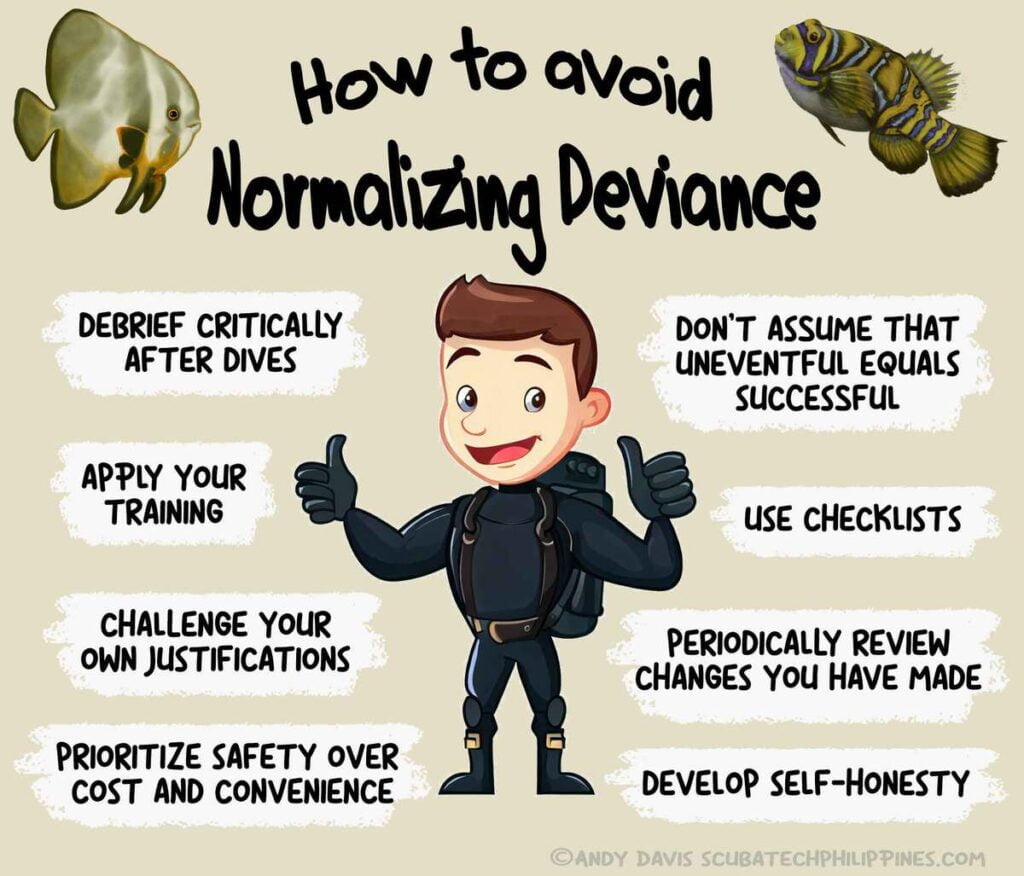
What is normalization of deviance?
Normalization of deviance refers to the process in which judgments or actions increasingly deviate from agreed best practices. This normalization can occur gradually and incrementally over time, leading people to embrace unideal behaviors or practices as the new norm.
The wider concept may also be referred to as ‘risk normalization‘; the gradual process through which higher-risk or dangerous, practices become acceptable over time.
This concept has been observed in various fields, including aviation, healthcare, and engineering, where it can have serious implications for safety and effectiveness.
What is the difference between normalization of deviance and normalization of risk?
Essentially, normalization of risk encompasses the process of gradually accepting risky behaviors in a broad sense, whereas normalization of deviance specifically addresses socially accepted deviation from established best practices that increase risk.
Normalization of Risk:
- Gradual acceptance of risky behaviors/practices as normal.
- Leads to reduced awareness or acknowledgment of potential risks.
- Can result in complacency, leading to accidents or negative outcomes.
Normalization of Deviance:
- Focuses on safety standard deviations becoming socially accepted as normal.
- Occurs when deviations from established standards are not acknowledged or corrected.
- Can lead to a false sense of security.
What is the normalization of deviance process?
Normalization of deviance is a process characterized by the gradual acceptance of deviations from established best practices, protocols, or safety guidelines.
This phenomenon unfolds over time, with each deviation reinforcing the perception that the new, non-standard practice is acceptable.
Here’s how normalization of deviance evolves:
- Initial Deviation: An individual, group, or organization makes an exceptional decision to violate established best practices, protocols, or safety guidelines, for a perceived short-term reward.
- Perception of Success: When these deviations yield no immediate negative consequences, a false sense of success develops, leading to the rationalization of disregarding established best practices.
- Normalization: The deviant behavior becomes the new norm, irrevocably distancing the organization, group, or individual from established guidelines.
- Repetitive Deviations: The cycle continues as there is a temptation to deviate even further from the new norm, resulting in incremental shifts from the original best practices.
- Accident and Catastrophe: Ultimately, the situation moves far beyond being ‘fail safe’. When an accident does finally occur, it can lead to catastrophic consequences due to the accumulation of deviations over time.
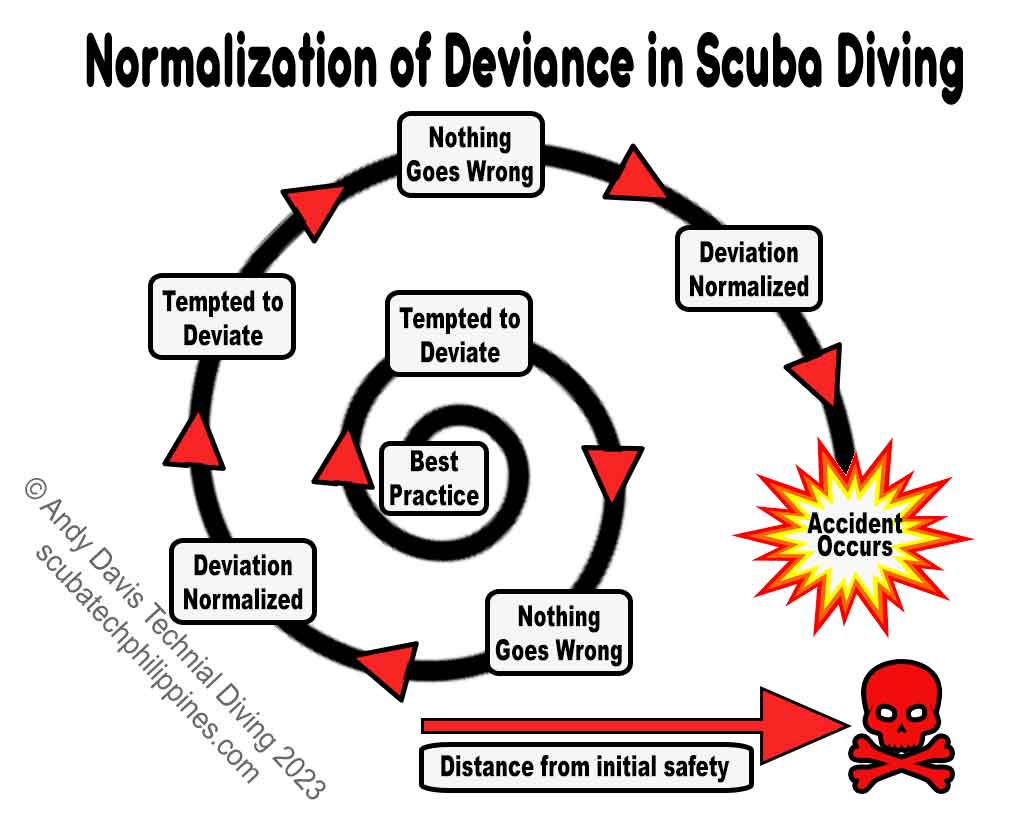
Evolutionary adaption favors normalization of deviance
Normalization of Deviance aligns with human nature: the normal inclination to seek ease, shortcuts, and efficiency.
In psychology, the tendency to favor effort-reducing behavior can be explained through evolutionary adaptation:
- Energy Efficiency: Early humans conserved energy to survive, leading to a preference for taking the path of least resistance through finding shortcuts and making minimal necessary effort.
- Quick Decision-Making: Efficiency in decision-making helped early humans respond swiftly to threats. Cognitive biases and heuristic judgments prioritize mental ease, speed, and convenience.
- Resource Allocation: Efficient allocation of time and effort enhanced survival chances. Seeking shortcuts allowed energy conservation for the most vital survival activities.
In short, evolved human behavior is aimed at conserving energy, ensuring swift responses, reducing risk, and efficient resource usage. This factors into normalization of deviance as the underlying natural tendency to seek convenient exceptions and easier shortcuts from agreed best practices.
Cognitive bias contributes to normalization of deviance
Cognitive biases play a significant role in contributing to the normalization of deviance within organizations, groups, and individuals. Here’s how they can influence this phenomenon:
- Confirmation Bias: People tend to seek out information that confirms their preexisting beliefs or decisions. When individuals deviate from established best practices, they may actively search for evidence that justifies their actions, reinforcing their deviation.
- Anchoring Bias: Anchoring bias occurs when individuals rely too heavily on the first piece of information they encounter. If someone initially perceives a deviation as inconsequential or justified, they may anchor their decision-making around that perception, making it challenging to correct the deviation later.
- Hindsight Bias: After a deviation, people tend to view it as less risky or problematic in hindsight. This bias can make individuals believe that their past deviations were less significant than they actually were, further normalizing such behavior.
- Groupthink: Groupthink is a bias that occurs when a group values consensus and harmony over critical evaluation. In organizations, groupthink can lead to collective acceptance of deviant practices, as individuals self-censor dissenting opinions.
- Status Quo Bias: People often prefer the current state of affairs, even if it involves deviations from established norms. This bias can lead to resistance against honestly evaluating and correcting deviant behaviors, perpetuating their normalization.
- Optimism Bias: Optimism bias leads individuals to underestimate the likelihood of negative outcomes. When people deviate from established norms, they may downplay the potential risks, assuming that things will turn out fine.
- Authority Bias: Individuals may unquestioningly follow the lead of authority figures, even when they deviate from best practices. This can contribute to the normalization of deviance if those with influence endorse or condone such behavior.
- Dunning-Kruger Effect: Individuals with low competence in a specific area tend to overestimate their ability and knowledge. This can enable normalization of deviance when people wrongly assume they know enough to dismiss the established best practices.
Where does the normalization of deviance concept come from?
The term “normalization of deviance” was first introduced by sociologist Diane Vaughan in her book “The Challenger Launch Decision: Risky Technology, Culture, and Deviance at NASA” which analyzed the tragic Space Shuttle Challenger (STS-51-L) disaster of 1986.
This catastrophic event, occurring just 73 seconds after liftoff, resulted in the loss of all seven astronauts aboard. The disaster was triggered by the failure of an O-ring seal in one of the solid rocket boosters, allowing hot gases to escape and subsequently exploding the rocket booster.
Vaughan’s in-depth analysis unveiled a disconcerting pattern:
The root cause of the Challenger disaster
The heart of the Challenger disaster lay in the repeated decisions made by NASA officials:
- Despite being acutely aware of a dangerous design flaw concerning the O-rings, which rendered them vulnerable to cold temperatures, NASA chose to proceed with the launch.
- Engineers at Morton Thiokol, the contractor responsible for the solid rocket boosters, voiced concerns about launching the Challenger in unusually cold temperatures on the day of the launch. Those concerns went unheeded.
Normalization of Deviance in the Challenger disaster
It is possible to recognize normalization of deviance in the cause of the Challenger disaster:
- NASA’s repeated deviations from established safety protocols regarding the O-rings and cold temperatures had become insidiously ingrained within the organization.
- The absence of any disastrous consequences in prior launches contributed to a false sense of security, leading to complacency in adhering to best practices.
- This normalization of deviant behavior allowed critical safety concerns, like those related to the O-rings, to be consistently downplayed and disregarded.
How does normalization of deviance affect divers?
Divers often identify shortcuts that save time, effort, and/or cost. Once decided upon, they will then rationalize in defense of their flawed judgment.
- In diving, set procedures and guidelines are established to ensure safety.
- However, divers sometimes opt to deviate from these procedures in favor of shortcuts.
- If no incidents occur during these deviations, the justification for the shortcut is reinforced, and it becomes the norm.
- Divers may use phrases like “It’s fine, I have always done it that way” or “It never caused me a problem” to outwardly justify their actions.
20 examples of normalization of deviance in diving
Scuba diving offers various scenarios where divers may fall victim to the normalization of deviance or risk.
I will leave it to the reader to consider whether these examples are socially accepted (normalization of deviance) within the wider diving community, or if they are generally acknowledged as safety process failures (normalization of risk) that demand correction.
Common deviations from established diving standards and best practices include:
- Neglecting to plan dives because a divemaster will lead.
- Omitting, or superficially conducting, pre-dive equipment checks.
- Failing to perform pre-dive safety checks with their dive buddy.
- Violating minimum gas reserves in favor of extending bottom time.
- Skipping safety stops due to impatience or boredom.
- Opting for instant gratification through fast-track (zero-to-hero) dive training schemes.
- Progressing quickly through the training system (card collecting) without building supportive experience.
- Choosing the cheapest, quickest, and most convenient dive training course available to obtain a ‘license’, rather than considering the quality of skills, knowledge, and proficiency gained.
- Feeling entitled to do a given dive through possession of a certification card, rather than evaluating their actual level of relevant competency for the dive.
- Exceeding certification limits, including maximum depths and no-stop times.
- Penetrating wrecks or caves without proper specialized training.
- Reducing decompression ascent conservatism to exit the water sooner.
- Purchasing new dive gear as a solution to skill deficiency problems.
- Neglecting nitrox or decompression gas analysis and proper cylinder markings.
- Proceeding with dives when feeling unwell instead of canceling.
- Failing to set a higher level of conservatism on dive computers in the presence of DCS predisposing factors.
- Accepting an aggressive schedule of repetitive multi-day diving to maximize the number of dives conducted on vacations or live-aboard trips.
- Justifying the use of air despite safety concerns warranting the use of nitrox or trimix gas.
- Disregarding fears, caution, or reservations to conduct dives beyond one’s ability, certification, or comfort level due to misguided assurances from irresponsible dive professionals (trust me dives).
- Refusing to abort dives when feeling uncomfortable, or experiencing difficulties, underwater.
Repeating poor judgment makes it easier to normalize such behavior for every dive, marking the onset of the slippery slope of normalization of deviance.
Purchase my exclusive ebook!
A comprehensive guide to the mindset and psychology of diving excellence.
$20 Printable PDF Format, 298 pages
The 4 categories of deviance in diving
1. Unintentional Errors (mistakes, slip-ups)
These deviations are accidental and are usually corrected quickly. However, repeated unintentional errors can become habits when;
The error is not recognized.
The error causes no negative outcome.
The individual/s chooses to use them as justification for continued deviance.
To prevent this:
Use checklists to reinforce adherence to procedures.
Conduct critical team debriefs after every dive.
2. Flawed Risk Appreciation
These deviations develop slowly and are challenging to tackle. They are a failure in diving risk assessment, and involve a combination of:
- Underestimating risk severity and/or likelihood.
- Over-estimating diving ability.
- Over-confidence of success.
Divers can be prone to falsely conflating ‘experience’ with proficiency. They are not the same.
3. Selective Justification
Selective Justification is a form of confirmation bias where divers cherry-pick accident statistics to trivialize the risks they take when diving. They ignore that accident statistics are not uniform or equal among all divers. As such;
- Most incidents happen to divers who don’t adhere to safe diving practices and make poor judgments.
- Accident likelihood is influenced by diver proficiency and the quality of their training relative to the dive undertaken.
4. Reckless Behavior (disregard of risk)
These deviations involve unreasonable and indefensible violations of protocols with seemingly little regard for danger. This behavior may be recognized through:
- Suppressed denial: an unspoken underlying irrational belief that ‘accidents only happen to others, but not to me‘.
- Projecting bravado: such as:
- “You Only Live Once” (YOLO)
- “Everybody dies sometime“
- “I’d rather die doing something that I love“
- Ego-induced delusion: the individual constructs a false narrative to justify a pleasing self-image of being an ‘explorer‘ or ‘pioneer‘.
- In reality, truly elite pioneering divers take very calculated risks and do their utmost to maximize safety through diligent risk mitigation.
- Deluded divers, on the other hand, happily tolerate easily avoidable risks that have well-known mitigation solutions to conduct dives with a mediocre level of challenge.
How to avoid normalization of deviance
Normalizing deviance can have serious consequences in various aspects of life, from workplace safety to personal habits. Avoiding this dangerous phenomenon demands self-awareness, self-honesty, and self-discipline.
1. Self-Awareness
The first step in preventing the normalization of deviance is self-awareness. This means recognizing that you or your team are capable of bad judgments that stray from best practices and safety standards. Here’s how to cultivate self-awareness:
- Regular self-assessment: Introspectively assess your actions, decisions, and behaviors to ensure they are reasonable, rational, and aligned with established standards. Regular self-reflection can help you detect deviations early.
- Self-critique for cognitive bias: Embrace the reality that you are fallible and are prone to unconscious cognitive biases and a tendency to favor ease. Learn to question and critique your judgment, beliefs, and justifications with that fallibility in mind.
2. Self-Honesty
Once you’re aware of making a deviation, the next critical step is self-honesty. This involves acknowledging the deviation without seeking to rationalize or justify it. Here’s how to practice self-honesty:
- Admit mistakes: Don’t be afraid to admit when you or your team have deviated from the norm, even if it’s uncomfortable or inconvenient.
- Examine your motives: Truthfully critique your reasoning behind a judgment or action. Is your motivation to strengthen safety, or is it to enable greater ease, more convenience, or reduce cost?
- Avoid rationalization: Resist the temptation to rationalize or downplay deviations. Acknowledge them as what they are: departures from established standards. Are you making ego-driven excuses for something you deep-down know is wrong?
- Seek feedback: Encourage and absorb open and honest feedback from colleagues or peers. Others may notice deviations that you’ve missed or recognize when you are making irrational justifications for your actions.
3. Self-Discipline
Self-discipline is the final piece of the puzzle. It involves taking corrective actions to address deviations and ensure they don’t become the norm. Here’s how to exercise self-discipline:
- Know the Standards: Understand the established diving standards, procedures, and best practices in diving. Without this knowledge, it’s challenging to identify deviations.
- Course Correction: When you identify a deviation, take immediate corrective action to bring things back in line with established standards.
- Establish Accountability: Set up mechanisms to hold yourself and your team accountable for maintaining standards. This could include routine debriefs, audits, or peer reviews.
- Consistency: Practice consistency in adhering to established safe diving practices. Over time, this consistency will help prevent deviations from becoming habitual.
- Stay Informed: Keep yourself updated with the latest information and evolving best practices in diving. You can deviate from the norm by allowing stagnation in your development.
By actively practicing self-awareness, self-honesty, and self-discipline, you can create a personal, group, and/or organizational culture that resists the normalization of deviance. This, in turn, promotes safety, quality, and excellence in diving.
Eliminate normalization of deviance from your diving
Normalization of deviance is a real threat to your safety as a scuba diver. By recognizing its signs, staying committed to safety, and promoting a culture of adherence to established norms, we can ensure that every dive remains a safe and enjoyable experience.
Remember, it’s better to be a responsible diver than to compromise safety for the sake of shortcuts or convenience.
Read more about Normalization of Deviance in Diving
Normalisation of Deviance: It’s not about rule-breaking, by Gareth Lock. The Human Diver, 22 Jul 2022.
Being a deviant is normal… by Gareth Lock. The Human Diver, 17 Jul 2016.
Drift is Normal. Being a Deviant is Normal. Here’s Why, by Gareth Lock. InDepth Magazine, 2 Aug 2021.
Normalization of Deviance, by Steve Lewis. Doppler’s Tech Diving Blog, 4 Mar 2015.
Further must-read articles on diving psychology
About The Author

Andy Davis is a RAID, PADI TecRec, ANDI, BSAC, and SSI-qualified independent technical diving instructor who specializes in teaching sidemount, trimix, and advanced wreck diving courses.
Currently residing in Subic Bay, Philippines; he has amassed more than 10,000 open-circuit and CCR dives over three decades of challenging diving across the globe.
Andy has published numerous diving magazine articles and designed advanced certification courses for several dive training agencies, He regularly tests and reviews new dive gear for scuba equipment manufacturers. Andy is currently writing a series of advanced diving books and creating a range of tech diving clothing and accessories.
Prior to becoming a professional technical diving educator in 2006, Andy was a commissioned officer in the Royal Air Force and has served in Iraq, Afghanistan, Belize, and Cyprus.
In 2023, Andy was named in the “Who’s Who of Sidemount” list by GUE InDepth Magazine.
Purchase my exclusive diving ebooks!
Normalization of deviance occurs in diving when a diver lapses from best practices, procedures, or standards in favor of ease, convenience, or economy. If no negative outcome occurs, the lapse is repeated to become the new norm. This process can reoccur over time, reducing the diver’s safety.
Originally posted 2023-09-21 16:39:03.









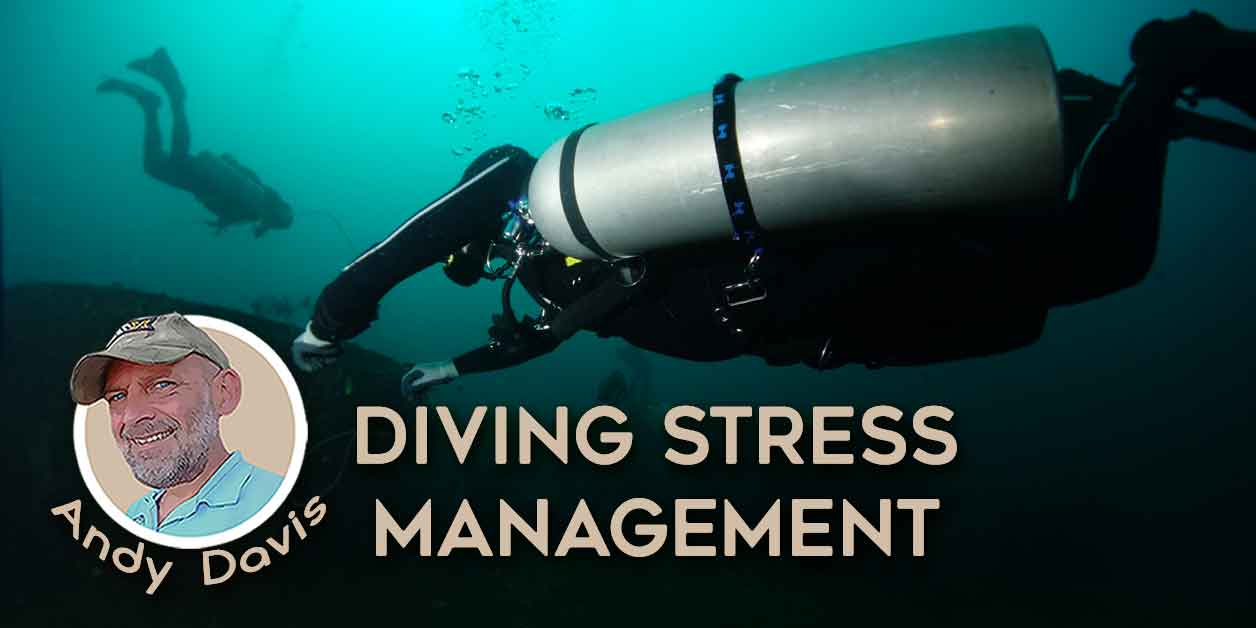
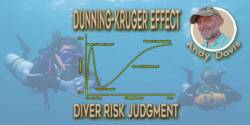

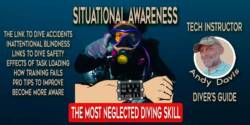

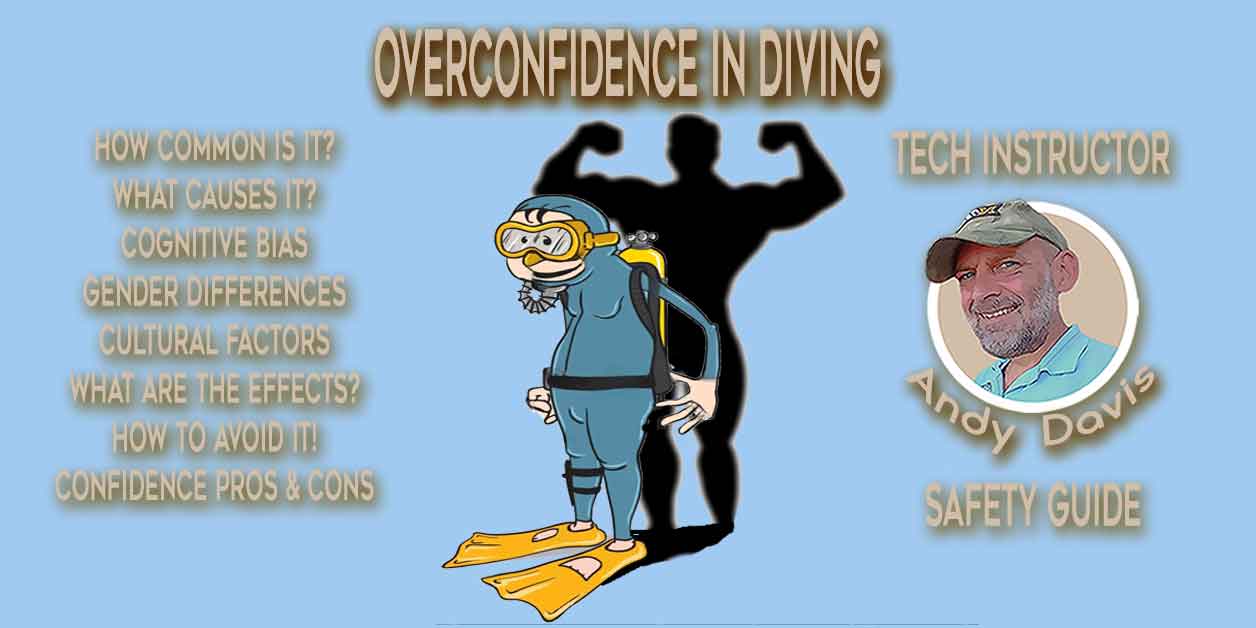
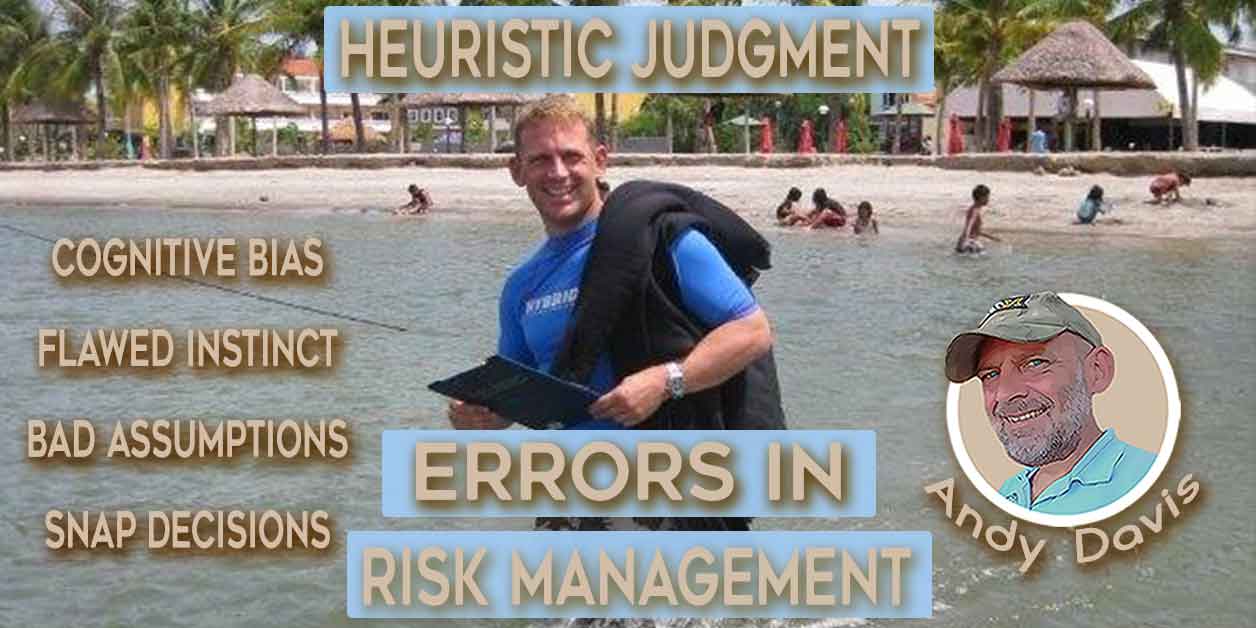
Love your diagram on normalization of deviance spiral. Would love to use this and modify it for healthcare. Will give attribution. Thanks.